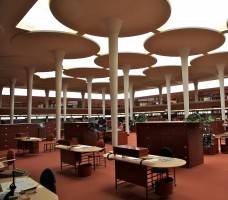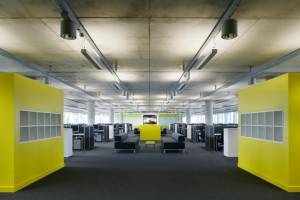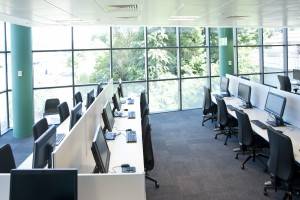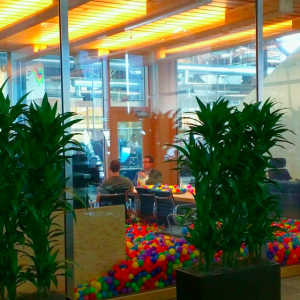 There is a lively and ongoing debate on whether open plan offices are a good or bad thing. Many articles would suggest that they routinely diminish productivity. Yes, the open plan office is not ideal for privacy and probably bad for conceptual focused work, but it’s a bit like saying a hammer is useless when you need to tighten a screw. The point is you don’t use it for that. Fans of open plan often underline how fantastic it is for building a sense of belonging, team spirit and ad hoc collaboration, often ignoring the challenges of working there. The point I’m making is that introducing open plan into your office is probably a good idea, but you really need to make sure that you provide your employees with a menu of settings which allow them to concentrate, have ad hoc meetings without disturbing their colleagues and provide some privacy for confidential conversations.
There is a lively and ongoing debate on whether open plan offices are a good or bad thing. Many articles would suggest that they routinely diminish productivity. Yes, the open plan office is not ideal for privacy and probably bad for conceptual focused work, but it’s a bit like saying a hammer is useless when you need to tighten a screw. The point is you don’t use it for that. Fans of open plan often underline how fantastic it is for building a sense of belonging, team spirit and ad hoc collaboration, often ignoring the challenges of working there. The point I’m making is that introducing open plan into your office is probably a good idea, but you really need to make sure that you provide your employees with a menu of settings which allow them to concentrate, have ad hoc meetings without disturbing their colleagues and provide some privacy for confidential conversations.
As Neil Usher put it recently: “In the perennial search for a scapegoat for the ills of labour in the knowledge economy, at irregular intervals the fourth estate rallies a clump of its pitchfork-waving townsfolk for a rousing pogrom against the easiest target of all – the `’open plan’ office.”
Where open plan fails
“There’s mounting evidence that the lack of privacy is causing people to feel overexposed in today’s workplaces and is threatening people’s engagement and their cognitive, emotional and even physical wellbeing.” Donna Flynn, Director of Steelcase’s WorkSpace Futures Research Group
“Many workplace productivity programmes focus on enhancing collaboration, at the expense of concentrated work, which can be equally important. Getting this delicate balance wrong can significantly inhibit your ability to develop new products and services and deliver them to your clients.” Forget the Workplace for Now” JLL Report, 2014
If you ask many employees working in open plan offices what is bothering them, they’ll probably tell you two things: that they cannot focus and they have no privacy.

EasyJet offices by Area Sq
According to a number of behavioural scientists and evolutionary biologists we all need some time to feel unobserved, unjudged and fully comfortable in our own skin. Modern, open plan based offices simply fail to cater to that need. According to Dr Nigel Oseland, “the absence of physical boundaries will increase the likelihood that co-workers and leaders will interfere with the employee discretion and freedom to work. This lack of autonomy may be a stressor.”
It seems that the ability to concentrate is even more impeded. If your job demands a lot of concentration, or learning and remembering new information, your efficiency can drop by as much as ten percent if you can hear people talking around you. Helena Jahncke, an environmental psychologist, used four different studies to examine how noise affects employees. In one of the tests, participants were asked to use several different tables of figures to find a residence built after 1963 that cost more than €57,000 and that had a floor space of less than 63m2. Assignments like this, where you need to remember variables and use them to find the correct information, were among the hardest for participants working in a noisy landscape. The costs would be higher for demanding work tasks requiring greater thought. Jahncke’s studies show that people tired more easily and became less motivated in noisy surroundings.
But is it possible to solve this problem by investing heavily in acoustic panels? Unfortunately it seems that many acoustic solutions only make matters worse. Jahneck suggests that intelligible speech ? understanding what your co-workers are saying ? is the most distracting noise for employees. Unfortunately, if you lower background noise you might make nearby conversations come through better but this can make these remedies counterproductive.
The statistics are quite shocking. According to one of the latest University of California studies, a typical office worker is interrupted as often as every 3 minutes. To make matters worse, it takes us up to 23 minutes to be able to return to the task at hand. Does starting to read the same page of a report for the third time sound familiar?

Talk Talk offices by Morgan Lovell
There are numerous studies pointing out other open plan deficiencies from increasing the number of sick days to increasing stress levels, but many of them were conducted with a really poor methodology as Dr Nigel Oseland describes in his article.
For instance, take the famous Danish study by Jan Pejtersen, which found that employees occupying single offices reported almost half the number of sick days (4.9 days) compared to open plan (8.1 days) and multi-person room employees (7.1-8 days). I found the study disappointing as it ignored the seniority of employees (aren’t single office occupiers usually more senior?) and only counted self-reported absenteeism (how often do managers really take sick days, rather than just work from home, if sick?), ignored the way people commute (are you more likely to catch the flu in tube or in your car?) and many other factors.
With all these issues in mind it seems that open plan may really may be the devil, but let’s consider the advantages before we make our minds up.
The benefits of open plan
The most obvious benefit of the open plan office is its cost efficiency. You only need 1/3 of the space to add a workstation in an open plan office in comparison to adding one in a single office. In places like London this translates into a considerable cost saving for a company.

Skype offices by Morgan Lovell
Secondly open plan significantly improves the knowledge exchange between employees (see the Knoll study). One thing that immediately starts happening when you move your employees to an open plan office is that they start experiencing the benefits of ‘constructive eaves-dropping’. People will talk about a problem or a project and suddenly somebody will join in with a good idea or a solution. In our rapidly changing business environment this is a key benefit.
Thirdly, and it’s connected to the previous point, open plan supports spontaneous brain storming. Whilst working in a single office you tend to deal with most of your problems alone or maybe with one other person, but in an open plan office it’s very easy to ask somebody for help and quickly exchange ideas with your team. This increased collaboration has significant results. According to one Harvard Business Review study, companies that encourage collaboration by switching from closed-offices to open-offices realise performance increases (speed and accuracy of work) by 440 percent.
Finally according to a number of recent researches (Gallup, Steelcase, Gensler, Knoll) open plan significantly increases the sense of belonging and team spirit. Sitting in an open plan office, you feel involved in what people around you are doing and you see their faces much more often. Many people feel left out and not ‘in the know’ sitting in a single office.
Not a universal solution
“We prefer landscapes that give us a clear view of what’s happening around us – open places that offer a broad vantage as part of a group as well as ready refuge places where we can hide if needed,” Meike Toepfer Taylor, Design Researcher, Coalesse

Teleperformance offices by Fresh Workspace
As the quote – widely attributed to Einstein – goes: ‘you can’t solve a problem with the same level of thinking that created it’. It is very hard to find a solution to guarantee communication and privacy and the ability to focus. Thankfully you don’t have to tear your hair out trying to decide if the benefits outweigh the drawbacks. You can have the cake and eat it too.
Creating an office that is tailored to employee needs, which provides a menu of settings is always the best solution. We are yet to find a company where the satisfaction level drops after the implementation of agile working also known as activity based working, flexible working etc.
Open plan is great for building a sense of belonging, allowing quick information exchange and works quite well when you have a routine or medium-focus-intense task at hand. However only by providing spaces for focused work, one on one conversations, confidential phone calls and quick ad hoc meetings will you be able to create a space that combines the benefits of a cellular environment with those of an open plan one whilst removing most of its drawbacks.

Facebook’s new offices with the world’s largest open plan
Is it more space efficient than one where employees use single offices? Yes, significantly. Is it more efficient than one where all that’s provided are desks in an open plan office and some meeting rooms? No if everyone has an assigned desk; yes if people desk-share.
Just to give an example, the 5th floor of my office at JLL, Warwick Street used to be mainly open plan, now it hosts the same amount of people with almost 30 per cent fewer desks (7 for every 10 employees). This allowed us to gain space for quiet rooms, a large café and plenty of meeting rooms, ad hoc meeting spaces and touchdown settings where visitors and employees can work for brief periods of time.
Providing single offices or rooms for employees is a rather lazy solution nowadays in my opinion. Yes you provide them with good privacy and a place to focus but there’s a lot that you lose. First thing that suffers is the sense of community, knowledge-sharing and spontaneous brain-storming. Besides with the current rent prices in London it’s hard to expect companies to move away from the open plan office. We hope however that they’ll add some other tools to their workplace box.
Main image: Frank Lloyd Wright’s design for the Johnson Wax headquarters, one of the first open plan spaces.
This feature also appears in the current issue of Work&Place.
______________________________
 Maciej Markowski is associate director in the Workplace Consultancy team at JLL, based in the London office. His background spans within workplace field, working for companies like CBRE and DEGW. He has international experience in corporate workplace, and change issues, advising major corporations on their workplace research, strategy, and change management.
Maciej Markowski is associate director in the Workplace Consultancy team at JLL, based in the London office. His background spans within workplace field, working for companies like CBRE and DEGW. He has international experience in corporate workplace, and change issues, advising major corporations on their workplace research, strategy, and change management.














May 29, 2015
Everything you wanted to know about open plan but were too distracted to ask
by Maciej Markowski • Comment, Facilities management, Work&Place, Workplace design
As Neil Usher put it recently: “In the perennial search for a scapegoat for the ills of labour in the knowledge economy, at irregular intervals the fourth estate rallies a clump of its pitchfork-waving townsfolk for a rousing pogrom against the easiest target of all – the `’open plan’ office.”
Where open plan fails
“There’s mounting evidence that the lack of privacy is causing people to feel overexposed in today’s workplaces and is threatening people’s engagement and their cognitive, emotional and even physical wellbeing.” Donna Flynn, Director of Steelcase’s WorkSpace Futures Research Group
“Many workplace productivity programmes focus on enhancing collaboration, at the expense of concentrated work, which can be equally important. Getting this delicate balance wrong can significantly inhibit your ability to develop new products and services and deliver them to your clients.” Forget the Workplace for Now” JLL Report, 2014
If you ask many employees working in open plan offices what is bothering them, they’ll probably tell you two things: that they cannot focus and they have no privacy.
EasyJet offices by Area Sq
According to a number of behavioural scientists and evolutionary biologists we all need some time to feel unobserved, unjudged and fully comfortable in our own skin. Modern, open plan based offices simply fail to cater to that need. According to Dr Nigel Oseland, “the absence of physical boundaries will increase the likelihood that co-workers and leaders will interfere with the employee discretion and freedom to work. This lack of autonomy may be a stressor.”
It seems that the ability to concentrate is even more impeded. If your job demands a lot of concentration, or learning and remembering new information, your efficiency can drop by as much as ten percent if you can hear people talking around you. Helena Jahncke, an environmental psychologist, used four different studies to examine how noise affects employees. In one of the tests, participants were asked to use several different tables of figures to find a residence built after 1963 that cost more than €57,000 and that had a floor space of less than 63m2. Assignments like this, where you need to remember variables and use them to find the correct information, were among the hardest for participants working in a noisy landscape. The costs would be higher for demanding work tasks requiring greater thought. Jahncke’s studies show that people tired more easily and became less motivated in noisy surroundings.
But is it possible to solve this problem by investing heavily in acoustic panels? Unfortunately it seems that many acoustic solutions only make matters worse. Jahneck suggests that intelligible speech ? understanding what your co-workers are saying ? is the most distracting noise for employees. Unfortunately, if you lower background noise you might make nearby conversations come through better but this can make these remedies counterproductive.
The statistics are quite shocking. According to one of the latest University of California studies, a typical office worker is interrupted as often as every 3 minutes. To make matters worse, it takes us up to 23 minutes to be able to return to the task at hand. Does starting to read the same page of a report for the third time sound familiar?
Talk Talk offices by Morgan Lovell
There are numerous studies pointing out other open plan deficiencies from increasing the number of sick days to increasing stress levels, but many of them were conducted with a really poor methodology as Dr Nigel Oseland describes in his article.
For instance, take the famous Danish study by Jan Pejtersen, which found that employees occupying single offices reported almost half the number of sick days (4.9 days) compared to open plan (8.1 days) and multi-person room employees (7.1-8 days). I found the study disappointing as it ignored the seniority of employees (aren’t single office occupiers usually more senior?) and only counted self-reported absenteeism (how often do managers really take sick days, rather than just work from home, if sick?), ignored the way people commute (are you more likely to catch the flu in tube or in your car?) and many other factors.
With all these issues in mind it seems that open plan may really may be the devil, but let’s consider the advantages before we make our minds up.
The benefits of open plan
The most obvious benefit of the open plan office is its cost efficiency. You only need 1/3 of the space to add a workstation in an open plan office in comparison to adding one in a single office. In places like London this translates into a considerable cost saving for a company.
Skype offices by Morgan Lovell
Secondly open plan significantly improves the knowledge exchange between employees (see the Knoll study). One thing that immediately starts happening when you move your employees to an open plan office is that they start experiencing the benefits of ‘constructive eaves-dropping’. People will talk about a problem or a project and suddenly somebody will join in with a good idea or a solution. In our rapidly changing business environment this is a key benefit.
Thirdly, and it’s connected to the previous point, open plan supports spontaneous brain storming. Whilst working in a single office you tend to deal with most of your problems alone or maybe with one other person, but in an open plan office it’s very easy to ask somebody for help and quickly exchange ideas with your team. This increased collaboration has significant results. According to one Harvard Business Review study, companies that encourage collaboration by switching from closed-offices to open-offices realise performance increases (speed and accuracy of work) by 440 percent.
Finally according to a number of recent researches (Gallup, Steelcase, Gensler, Knoll) open plan significantly increases the sense of belonging and team spirit. Sitting in an open plan office, you feel involved in what people around you are doing and you see their faces much more often. Many people feel left out and not ‘in the know’ sitting in a single office.
Not a universal solution
“We prefer landscapes that give us a clear view of what’s happening around us – open places that offer a broad vantage as part of a group as well as ready refuge places where we can hide if needed,” Meike Toepfer Taylor, Design Researcher, Coalesse
Teleperformance offices by Fresh Workspace
As the quote – widely attributed to Einstein – goes: ‘you can’t solve a problem with the same level of thinking that created it’. It is very hard to find a solution to guarantee communication and privacy and the ability to focus. Thankfully you don’t have to tear your hair out trying to decide if the benefits outweigh the drawbacks. You can have the cake and eat it too.
Creating an office that is tailored to employee needs, which provides a menu of settings is always the best solution. We are yet to find a company where the satisfaction level drops after the implementation of agile working also known as activity based working, flexible working etc.
Open plan is great for building a sense of belonging, allowing quick information exchange and works quite well when you have a routine or medium-focus-intense task at hand. However only by providing spaces for focused work, one on one conversations, confidential phone calls and quick ad hoc meetings will you be able to create a space that combines the benefits of a cellular environment with those of an open plan one whilst removing most of its drawbacks.
Facebook’s new offices with the world’s largest open plan
Is it more space efficient than one where employees use single offices? Yes, significantly. Is it more efficient than one where all that’s provided are desks in an open plan office and some meeting rooms? No if everyone has an assigned desk; yes if people desk-share.
Just to give an example, the 5th floor of my office at JLL, Warwick Street used to be mainly open plan, now it hosts the same amount of people with almost 30 per cent fewer desks (7 for every 10 employees). This allowed us to gain space for quiet rooms, a large café and plenty of meeting rooms, ad hoc meeting spaces and touchdown settings where visitors and employees can work for brief periods of time.
Providing single offices or rooms for employees is a rather lazy solution nowadays in my opinion. Yes you provide them with good privacy and a place to focus but there’s a lot that you lose. First thing that suffers is the sense of community, knowledge-sharing and spontaneous brain-storming. Besides with the current rent prices in London it’s hard to expect companies to move away from the open plan office. We hope however that they’ll add some other tools to their workplace box.
Main image: Frank Lloyd Wright’s design for the Johnson Wax headquarters, one of the first open plan spaces.
This feature also appears in the current issue of Work&Place.
______________________________